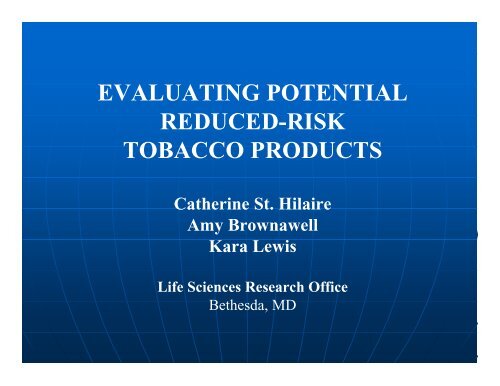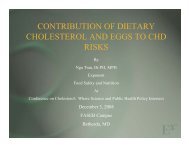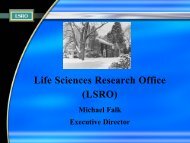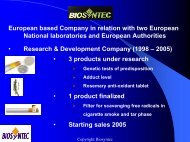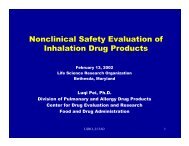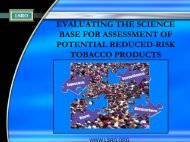Tobacco Science Research Conference - Life Sciences Research ...
Tobacco Science Research Conference - Life Sciences Research ...
Tobacco Science Research Conference - Life Sciences Research ...
- No tags were found...
You also want an ePaper? Increase the reach of your titles
YUMPU automatically turns print PDFs into web optimized ePapers that Google loves.
EVALUATING POTENTIALREDUCED-RISKTOBACCO PRODUCTSCatherine St. HilaireAmy BrownawellKara Lewis<strong>Life</strong> <strong>Science</strong>s <strong>Research</strong> OfficeBethesda, MD
PurposeThe purpose of the Reduced RiskReview Project (RRRP) is todevelop a science-basedprocess to evaluate and assessthe risk-reductionreductioncharacteristics of potentialreduced-risk risk tobacco products(PRRTP).
Goals• Identify the scientific informationneeded to assess risk reduction• Establish criteria to evaluate thescientific information, includingspecification of comparisonbenchmarks• Define a process to review thescientific information
Context• Public health: : Cigarette smoking isthe number one preventable causeof death and disease in the UnitedStates. One out of every five adultssmokes cigarettes.
Context• Public policy: : Reducing adversehealth impacts in smokers who willnot or can not abstain from the useof tobacco products through the useof reduced-risk risk tobacco products ishighly controversial.
Trends in Smoking
Cessation Statistics
<strong>Tobacco</strong> Control Concerns• Distrust of the industry coupledwith the absence ofcomprehensive regulatoryoversight• Scientific uncertainty• Adverse population effects• Detracts from abstinencemessage
Testing Sequence
Hatsukami et al.• Chemistry: identify toxins inproduct and smoke; machine-generated smoke chemistryyields• Preclinical: Cell culturestudies, preclinical animaltrials of exposure to productand toxins
Hatsukami et al.• Comprehensive clinical trials forexposure reduction, patterns ofuse, health effects (biomarkersrelevant to carcinogen uptake,cardiovascular and lung functionusing comprehensive panel ofbiomarkers)• Studies of consumer perceptions,market research on consumerperceptions
Differences• Abuse liability testing• Potential population effects:behavioral studies, surveys,and evaluation of marketingand advertising messages(to assess perceptions anddemand for product)
Clearing the SmokeThe inherent tension facing thescientific and public healthcommunities—There is an urgent need toevaluate products/claims, butthe science base isincomplete.
Risk Assessment• Risk assessment methods are usedto guide public health policy decisionmaking when the science base isincomplete and/or uncertain• Use of a risk assessment approachfor the evaluation of PRRTPsprovides a framework for thesystematic evaluation of scientificevidence and uncertainties
<strong>Science</strong> and Judgmentin Risk AssessmentUncertainties are addressed by• Scientific cientific assumptions (basedon what is most likely to becorrect)• Risk assessment policy(insufficient information todevelop a ‘best guess’ so mosthealth-protective scientificassumption is used)
Examples of Information GapsInformation GapThe relationship betweenexposure to specific smokeconstituents anddevelopment of disease hasnot been establishedAssumptionReduction in one or moretoxicants may indicate thepotential for reducedexposure and reduced risk ofdisease
Examples of Information GapsInformation gapCurrentlyavailable animalmodels arelimited in theirrelevance tohuman diseaseAssumptionEvidence of reducedtoxicity in animals isan indication thatadverse effects inhumans may bereduced
Examples of Information GapsInformation gapThe degree ofexposure reductionneeded to reducedisease risk has notbeen establishedAssumptionAs exposure isreduced, risk isalso likely to bereduced
Examples of Information GapsInformation gapThe role ofcurrently availablebiomarkers ofeffect in thedevelopment ofdisease has notbeen establishedAssumptionBiomarkers ofeffect areacceptableindicators ofbiological processesassociated with thedevelopment ofdisease
<strong>Science</strong> and Judgmentin Risk Assessment• Clarity and credibility of a riskassessment are significantlyincreased when scientific facts(actual data) are clearlydistinguished from assumptionsbased on ‘best guess’ or ‘mosthealth-conservativeconservative’
<strong>Research</strong> and RiskAssessment ElementsPreclinical:Short-termtermbiological assays;animal studiesClinical:Biomarkers ofeffect studiesBiological EffectsAssessment (BEA):What is the evidencethat use of thePRRTP instead ofconventionalcigarettes results inbiological changesthat indicate reducedrisk?
<strong>Research</strong> and RiskAssessment ElementsPreclinical:Short-termtermbiologicalassays; animalstudiesClinical:Biomarkers ofeffect studiesBiological EffectsAssessment (BEA):What is the evidence thatuse of the PRRTP insteadof conventional cigarettesresults in biologicalchanges that indicatereduced risk?
Weight of Evidence• A process that assigns levels ofimportance (“weights)(to evidencebased on a number of factors suchas type of study, quality of study,relevance to outcome of interest• Sequence of testing coincides withincreasing weight
Sufficiency of EvidenceSourceHatsukamiand Hecht,2005ClaimReduced exposure[Reduced toxicity]Reduced harmEvidence RequiredClinical trials of toxinexposure, patterns ofuseClinical trials of healtheffects of toxicity andabuse liability studiesPost marketingtesting, longitudinalstudies, epidemiologicstudies
Sufficiency of EvidenceSourceIOM,2001ClaimReducedexposureReduced riskReduced harmEvidence RequiredConsistent finding of reducedexposure in human biomarkerstudies and evidence ofreduced toxicity in clinicalstudiesConsistently reducedtoxicity/biomarkers ofpotential harm and decreasedabuse liabilityEpidemiologic studies showreduced diseaseincidence/mortality
Sufficiency of EvidenceSourceWHO,2003ClaimSmokecompositionReducedexposureReduced riskpotentialReducedharmEvidence RequiredEmissions dataAdequate studies in fullycharacterized subpopulationsMeasures of injury usingvalidated biomarkers showreduced toxicity; measures ofaddiction potential show noincreaseEpidemiologic studies showreduced diseaseincidence/mortality
Sufficiency of EvidenceSourcePhilipMorrisUSAClaimReducedexposureReduced riskReducedharmEvidence RequiredHuman biomarkerstudies showconsistent reductionHuman health effectbiomarkers showreductionEpidemiologic datashow reduced harm
Decision Making: <strong>Science</strong> + Policy• “<strong>Science</strong>” is the PRRTP riskassessment describing the relativerisk of the PRRTP compared toconventional cigarettes• “Policy” includes all other relevantconsiderations, e.g.regulatory/legal, ethical, social,economic, political…
Framing the Decision• Is the scientific evidencesufficient to conclude that aPRRTP is likely to reduce risk?The focus is on relative risk andthe potential to reduce risk ofdisease in smokers who cannotor will not quit(continuingsmokers)
Framing the Decision• Is the evidence sufficient toconclude that a PRRTP is safe?• The focus is on safety (definition?benefits outweigh risks?) not relativerisk• Because tobacco products are knownto cause certain diseases, a PRRTPwill never be deemed to be ‘safe’• This focus is a deal breaker
Framing the Decision• Will the use of a PRRTP contributeto or detract from abstinence fromtobacco use/nicotine addiction?• Also a deal breaker• CSH observation—Many tobaccocontrol professionals reject any formof harm reduction including PRRTPsand NRTs on this basis
Framing the Decision• Is there sufficient evidence toconclude that population risk willnot increase due to the availabilityof a PRRTP?• Also a deal breaker• Scientific methods to assesspotential population impacts arewoefully inadequate (pre- andpostmarketing)
Smokeless <strong>Tobacco</strong> (ST)Scientific consensus: Smokelesstobacco (of the type used inWestern cultures) has beendemonstrated to be a reduced-harm tobacco product. Evidencefor significant reductions in harmis strongest for low-nitrosamineproducts such as snus.
ST and WHO• There is no evidence to recommendthat any smokeless tobacco productshould be used as part of a harmreduction strategy• The designation of ST as harm-reducing agents may promote a falseperception of safety. Risk reduction isachieved by reducing smokingincidence and not substituting anotherform of tobacco use.
Summary• Scientific approaches recommended toassess PRRTPs are generally consistent• The devil is in the details—we believethat the LSRO report will providesufficient detail to stimulate scientificdialogue• TC/PH opposition to marketingreduced-risk risk tobacco products(with claims) in the absence ofgov’t t regulation is especially strong


